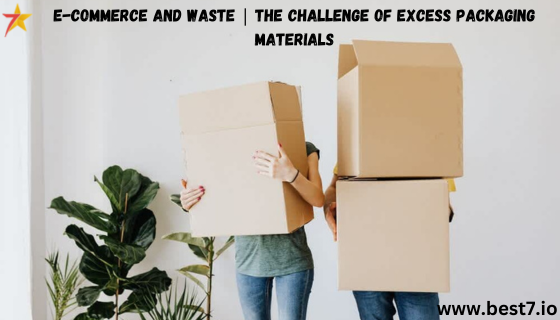
E-commerce has made shopping more convenient for consumers but also resulted in a major boost in packaging waste. The rise of online shopping coincided with the inevitable reality that packaging used to deliver goods was not environmentally friendly.
Questions about sustainability and waste management were born out of the excess packaging materials. The implications of this issue are serious, with effects not just on waste management systems but also on pollution and depletion at a resource level.
In this piece, we look at the problems causing e-commerce waste with excess packaging and what eco-friendly solutions there are and whether these will be scaled to address the issue sooner rather than later by referring to some example from the past about reducing waste.
1. E-Commerce: Environmental Impact of Over-wrapping
The impact of e-commerce packaging waste was significantly felt on the environment. With the rise of online shopping in recent years, it brought a lot more demand for all things plastic to carry our deliveries.
The estimated retail trade is about 30% more packaging waste increase in e-commerce than by traditional trading because the goods have to be packed for transport and completed on pallets. Most of this packaging was made from plastic, cardboard, and other hard-to-recycle materials.
How A Group Of Young Entrepreneurs Created The World’s Foremost Sustainable Packaging Company The environmental impact of packaging went far beyond trash. Both in the generation and eventual disposal of packing materials were impacts created, along with contributing to greenhouse gas effects and extracting more natural resources.
In 2020, studies found that the creation of packaging materials for e-commerce accounted for 10 percent of the retail sector’s entire carbon footprint. With more organizers that want to take advantage of the rise of e-commerce, the call for template-less and sustainable solutions in the field has only increased.
The trend toward sustainable packaging was born not only of an aroused public conscience but also of the fact that rising numbers of purchasers simply expect and require earth-friendlier ways to do business.
The e-commerce waste issue also exacerbated the problems with urban waste management systems, which were having trouble dealing with all of the waste from packaging. Non-recyclable packaging materials were not properly dealt with and ended up as pollution—eespecially in watersheds and landfills.
The need of the hour With the surge in online shopping, waste management in e-commerce became a cause for concern, wherein businesses had begun exploring options to align themselves with the practices least harmful to the environment.
2. The Future of Sustainable Packaging: Waste Reduction Solutions
Responding to the packaging waste problem, companies started looking for alternative sustainable options pertinent to e-commerce. Developing packaging with less waste was a focus, and several things were done to reduce the footprint of packaging.
Businesses began to explore the idea of a circular economy—creating a closed-loop system that recycles and re-uses what they produce.
With the growing concern for the environment, biodegradable packaging materials became an ideal solution. Less than 5% of the total packaging used for e-commerce was estimated to be comprised of biodegradable materials in 2020.
But this was expected to increase, with projections suggesting it would reach 20% by 2028 as companies embraced biodegradable materials instead of traditional plastics. These materials were composed of natural substances such as cornstarch and paper, which decomposed faster and were less harmful to the environment.
Recyclable materials as well played a key role in the waste reduction strategies implemented. Then came cardboard packaging for e-commerce companies, not only recyclable but made from sustainably managed forests as well.
It not only helped in minimizing the waste but also cut down carbon footprints that are produced while making packaging material. The 50% e-commerce packaging demand with recycled products by 2030 also leads to sustainable e-commerce practices.
Innovation and design solutions too help count waste reduction. These days, companies began using simple packaging that uses fewer materials but still guarantees the safety of a product. Not only did it decrease waste, but it also reduced emissions produced by transportation—bbecause lighter packages use less fuel to ship.
The adoption of these sustainable e-commerce solutions was in response to the rising concern over packaging waste and, among other things, has helped businesses take a step closer toward creating a circular economy.
3. How the Consumer Behavior And The Packaging Waste Are Related To The E-Commerce Sustainability
The way consumers behaved led the path in all those businesses responding to packaging waste on e-commerce. Recent research suggests that consumers are favoring more and more companies that show a commitment attitude towards sustainability.
Consumer surveys by 2022 were giving results of over 70% of consumers preferring eco-friendly packaging even if it cost them more. Accordingly, word travels fast, and consumers forced businesses to rethink waste reduction strategies and eco-friendly packaging materials.
Consumer behavior also influenced the decision, other than reasons relating to eco-packaging. Consumers were even actively looking for e-commerce companies that minimized harmful gases and preferred sustainable transportation methods of e-commerce green logistics.
As they aligned with these values, organizations established greater customer dedication and a more positive brand perception. And the predictions went on that consumer demand for sustainable packaging would propel another 40% surge in eco-friendly materials by 2025.
The desire to keep up with consumer expectations also influenced packaging innovations in e-commerce. Re-use of packaging: Some companies were trying to make use of re-usable packaging in order for consumers to send back such packagings using normal return packages and so they could be reused in future orders.
They were helping to decrease waste and encouraging a sustainable way of life. They are also forecasted to represent 15% of the total plans for e-commerce packaging by 2030 as companies look to capitalize on consumer demand for sustainable options.
Finally, it can also be said that packaging waste management is connected to consumer behavior and regulatory developments. In response to public concern, governments imposed tighter restrictions on packaging materials and how waste could be disposed of.
This move was further accelerated by new guidelines issued by the European Union in 2021 that mandated firms to use recyclable packaging, causing a shift towards sustainable practices among e-commerce companies. For the year 2030, it was already implied that these rules will be adopted in all countries, which would oblige companies of any size to take greater care with questions related to sustainability.
4. E-commerce Waste Management: Innovations & Future Trends in Packaging
E-commerce packaging innovations had continued to grow, driven by the needs of more sustainable challenges and predictive fulfillment forecasts. 7 major developments that influenced the future of packaging waste management in e-commerce are:
1. Biodegradable Packaging Materials: The demand for biodegradable materials continues to rise as companies race up their efforts in minimizing their environmental impact. In 2028, 30% of all e-commerce packaging is expected to be biodegradable, subsequently cutting landfill waste and driving circular economy.
2. Reusable Packaging Systems: Businesses experimented with reusable packaging systems to cut down waste. Its 2030 forecast was for these systems, which allowed consumers to return packaging to be cleaned and refilled, to account for 10% of the market.
3. Recycling Initiatives: Recycling programs from companies that contribute to improved management of packaging waste. The report forecast that, by 2030, recycling more complex e-commerce packaging could reach a 60% recycling rate, assisted in particular through innovation in recycling methods and infrastructure.
4. Innovation in Smart Packaging Technology: With solutions like smart packaging technology, businesses could better plan their use of packaging and reduce wastage. According to the same source, by 2032, approximately 15% of e-commerce packaging was projected to be equipped with smart features such as sensors and RFID tags in order to more efficiently manage the logistics.
5. Minimal: The trend of packaging design is moving towards minimalistic design, thereby reducing the amount of material used. As of 2025, you can also envisage that minimalistic packaging will become the new norm for at least 40% of companies within the e-commerce sector.
6. Regulatory Assistance for Sustainable Packaging: Various governments introduced strict norms to encourage the use of sustainable packaging. Eight out of 10 countries were expected to have implemented policies requiring that e-commerce orders be shipped in environmentally friendly packaging by 2030.
7. Partnership with Waste Management Services: E-commerce worked closely with waste management services for better recycling and lower waste. They eventually aimed to have 50% more of these partnerships by 2035, creating a more sustainable solution for this packaging waste.
Over time, these innovations have become increasingly sophisticated to the point the point where now small businesses have the opportunity to solve a major e-commerce sustainability issue: packaging waste.
Cello bags and polystyrene were gradually phased out in favor of recyclable, biodegradable packaging, making huge steps to reduce the environmental impact of packaging. Given that regulators are increasingly placing the onus on the manufacturer to manage their packaging materials, consumer behavior was moving toward this change and potential for a new era for how e-commerce should happen in an environmentally sustainable manner.












